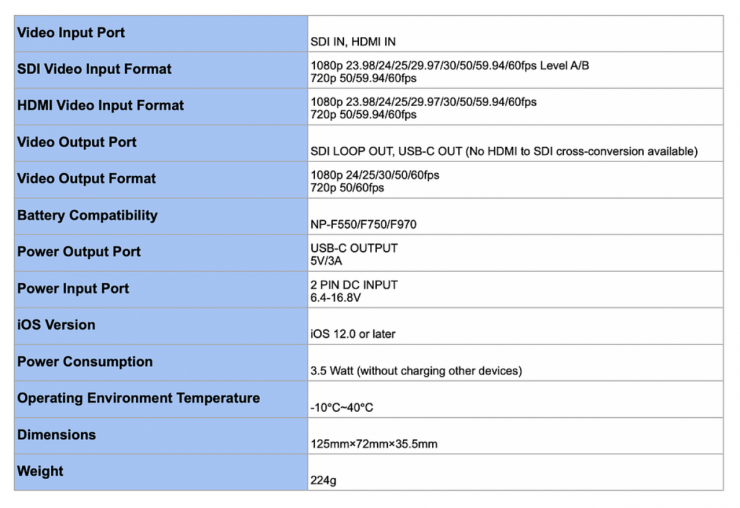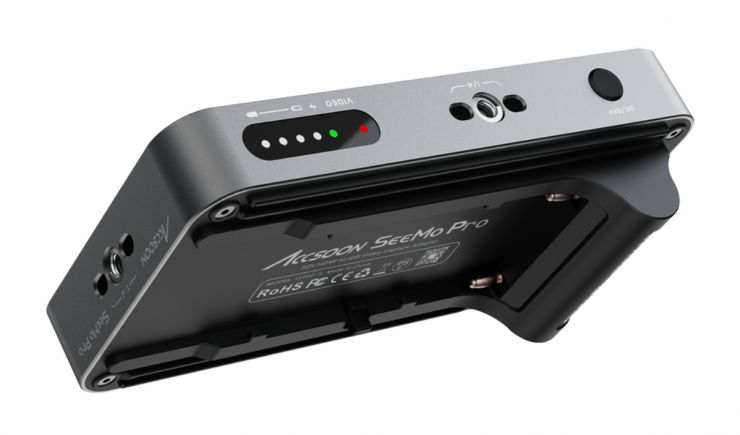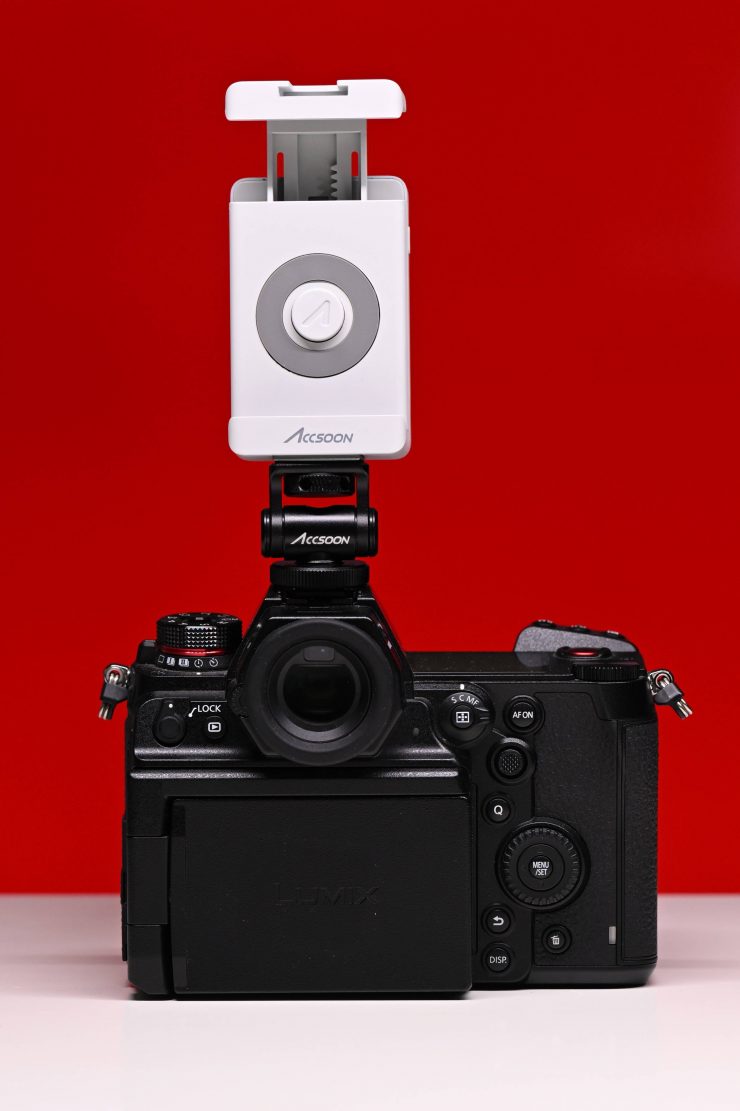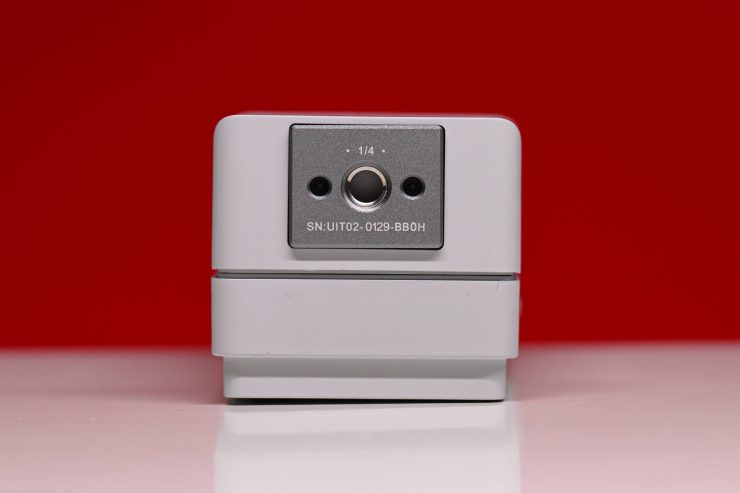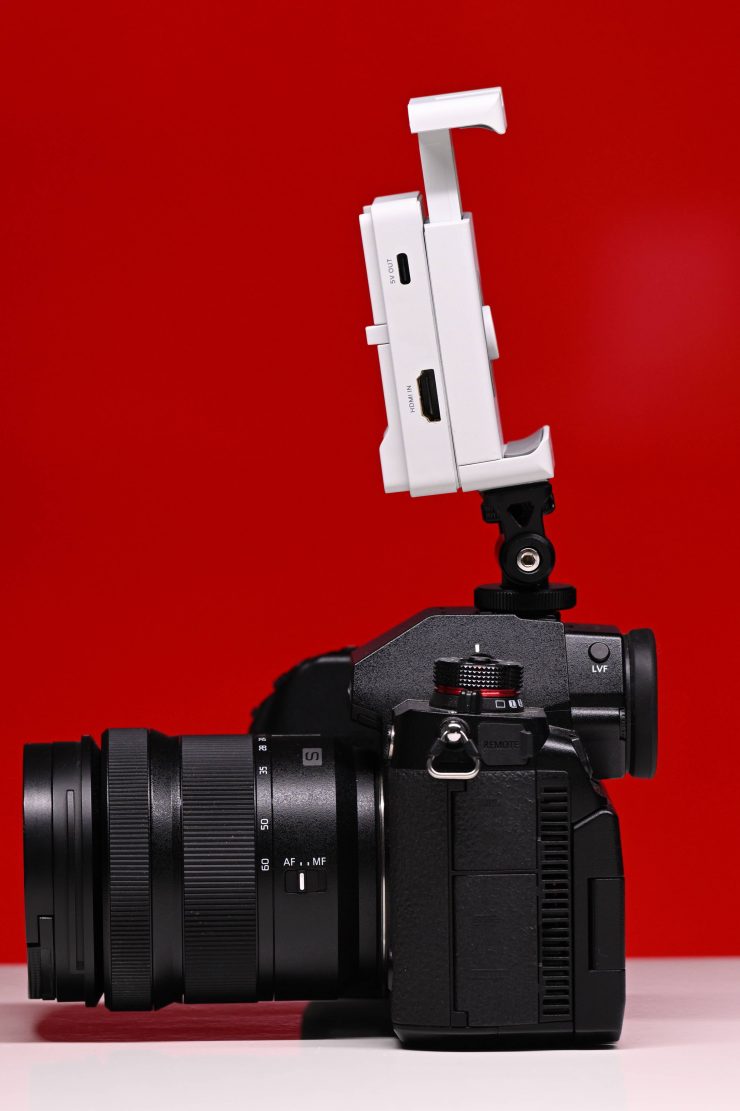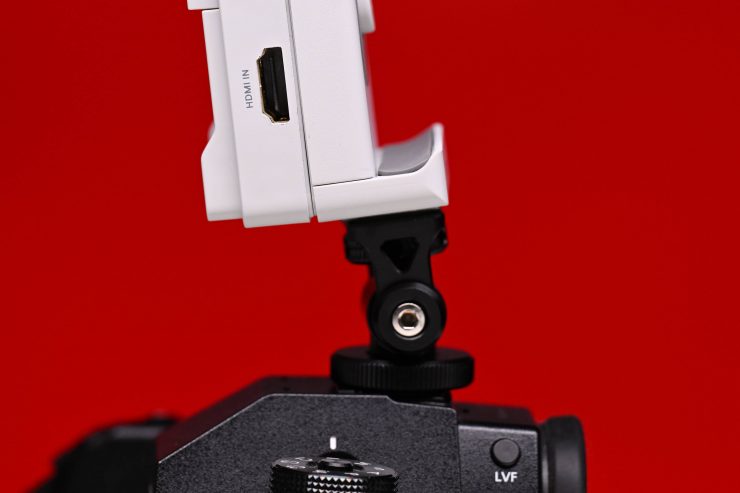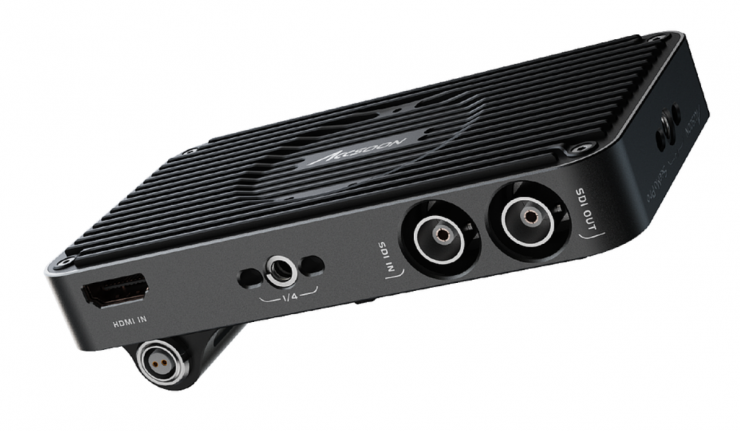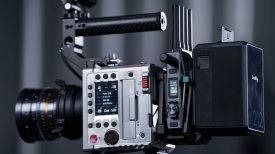
The Accsoon SeeMo Pro SDI monitoring/recording/streaming adapter for iOS is built on the technology of the original SeeMo HDMI model. The SeeMo Pro SDI is a small box that goes in between your camera or other SDI/HDMI source and your iOS device via Lightning or USB-C cable.
The SeeMo Pro SDI can accept HD signals up to 1080p 60fps over either HD SDI or HDMI from cameras, mixers, games consoles and wireless receivers. The HD SDI input can also be looped out to allow connection to other downstream devices such as Accsoon’s own CineView SE and Quad SDI wireless transmitters.
Above you can see our interview with Accsoon at NAB 2023.
Concept
The whole concept was pretty simple. Make a professional adapter that can convert an SDI or HDMI signal so it can be viewed on an Apple iPhone or iPad.
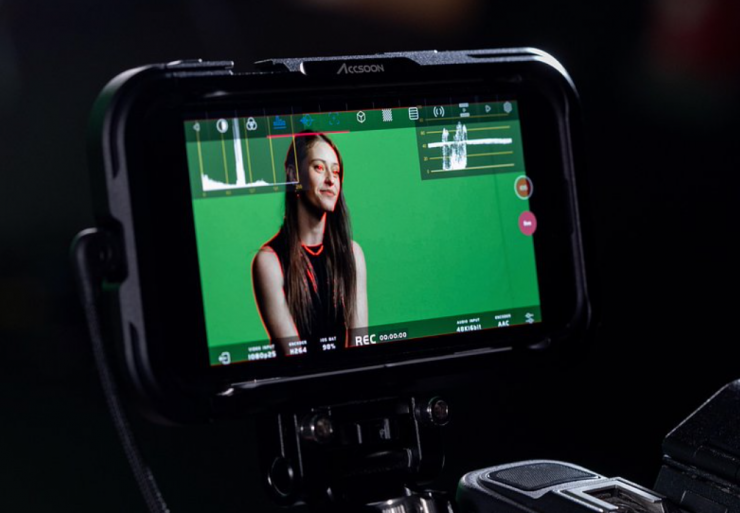
When combined with the free Accsoon SEE app it transforms any recent iPad or iPhone into a fully featured production monitor with a complete set of professional tools such as waveform, magnification, vectorscope, false color, peaking and audio level meters. Users can apply custom LUTs, or use the onion skin image overlay to precisely line up their shots. There are even options to de-squeeze anamorphic video on-screen, or flip video to aid self shooting.
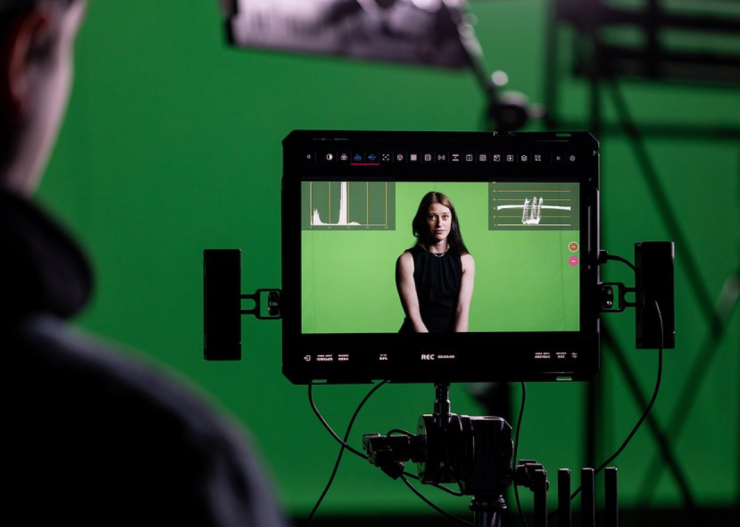
SeeMo Pro SDI can also turn larger iPads and iPad Pros into directors’ monitors with the aid of Accsoon’s line of PowerCages for iPad. The latest PowerCage II and PowerCage Pro II surround the iPad with metal protection and provide a solid way to mount the SeeMo Pro SDI to the rear of the setup. A built-in kickstand allows it to be set down safely without toppling over.
You can record HD video input via SeeMo Pro SDI direct to your iOS device’s camera roll at up to 1080p at 60fps 8-bit in H.264 variable bitrate.
The SeeMo Pro SDI will also turn an iPhone into an SDI/HDMI EVF with the upcoming Zacuto Z-finder iOS electronic viewfinder solution. Announced back in April, it has been developed in collaboration with Accsoon and uses a customized version of the SEE app.
Size & Weight

If you are going to make a product that is going to be primarily used with small to mid-sized digital cinema cameras then it can’t be too big or too heavy otherwise no one will want to use it.

The Accsoon SeeMo Pro weighs 224g / 7.9 oz. This isn’t too bad, but some dedicated 5″ monitors aren’t going to weigh that much more. What you clearly need to remember is that if you want to power the Accsoon SeeMo Pro using a Sony NP-F style battery then that weight will certainly increase.
Now, according to Accsoon, the idea has always purposely been to have the SeeMo Pro mounted separately on the camera instead of on the back of an iPhone or iPad. The reason for this is to create far better weight distribution, and the company says that you also end up with a much lighter iPad or iPhone being used as your monitor. There are also fewer heat dissipation issues. The other reason is that if you break one part there is only one part to replace, not the whole thing.
My concern is that as you need to mount the Accsoon SeeMo Pro and an iPhone separately you are taking up a lot of real estate on your camera. If you just use a 5″ monitor then it is only one device you need to mount and connect up. Yes, I do understand that on smaller-sized cameras having two separate components could lead to better weight distribution, however, on smaller cameras, you also have less real estate to work with.

Even when I mounted up a basic configuration on an ARRI Amira I found that it takes up a lot of real estate. I kept asking myself what would the benefit be of using this over a 5″ monitor.
Build Quality
The build quality of the Accsoon SeeMo Pro is very good and way better than that of the standard SeeMo. The casing is made out of the same type of material that is used in Accsoon’s wireless video transmission products.
There are no plastic parts and it certainly looks like it could easily survive out in the field in tough conditions.
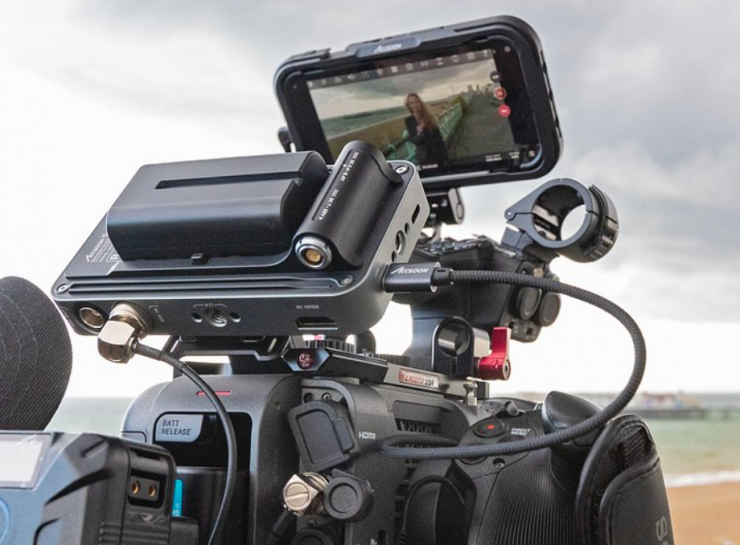
The SeeMo Pro SDI features a tough lightweight aluminum body with multiple 1/4-20 anti-rotation mounting points.
How do you power it?
SeeMo Pro SDI runs off Sony NP-F style batteries or via a pro-grade 2-pin DC connector. It can supply 5V/2.4A power to a connected iPad or iPhone for extended operation times. It can also charge other devices over USB-C operating as a power bank.
I would personally power the SeeMo Pro via the 2-pin DC connector as adding an additional battery just starts making everything bigger. It also, at least in my opinion, makes more sense to power it via the DC input as that way it will stay on and when you turn your camera on it is already powered up. As it only draws 3.5W you can leave it turned on all day if need be.
Mounting

For on-camera monitoring, the SeeMo Pro needs to be mounted somewhere on your camera and then you also need to mount your iPhone separately. As I previously mentioned, this does mean that you are taking up quite a bit of real estate on your camera. If you are using a smaller-sized digital cinema camera you need to weigh up whether this solution is going to be too big and require too many cables. My personal opinion is that I don’t like having to use multiple components for my monitoring need, however, some users may like the ability to run two separate components.
Conversely, the original SeeMo is an all-in-one unit which means that it doesn’t take up nearly as much space. If I had a smaller camera that outputs HDMI, I think this makes for a better solution.
With the SeeMo Pro, you also need to take into account that the included USB-C to Lighting cable that comes in the kit isn’t very long so that will limit the distance you can place it and your iPhone apart. Accsoon does sell extended 1m Lightning cables where additional length is required.
The SeeMo Pro features four 1/4-20″ threads (one on every side) which certainly helps with mounting.

I didn’t have the best of solutions for mounting a phone. Something like the Tilta Rotatable Phone Mounting Bracket would make more sense.
Inputs & Outputs
The SeeMo Pro SDI has an HD SDI input and output with a loop-through. There is also a full-sized HDMI input
What signals can it accept?

The Accsoon SeeMo can accept Full HD signals at up to 60p. It can also output Full HD video at up to 60p.
Plug & Play?

The Accsoon SeeMo Pro is very easy to get up and running. The first thing you need to do is to download the free Accsoon See app from the App store.
You then connect the lighting to USB-C cable from your phone to the SeeMo and then connect an SDI or HDMI cable from your camera to the adapter.
It isn’t as quick to set up as the Accsoon SeeMo because that allows you to attach your phone directly to the adapter. With the Accsoon SeeMo Pro you need to put your iPhone or iPad into a cradle or some type of other mount

You then turn your camera on, turn the SeeMo Pro on and open the app that you downloaded.

In a nice touch, as soon as you have everything connected up you will get an immediate prompt to open the app directly.
Once the app has opened, all you need to do is to press the Monitor icon on the screen and you are good to go.

There is also a page where you can change settings, update firmware and find links to tutorials and the operating manual.

Once you are connected up you will see a real-time image from your camera displayed on your iPhone.
Monitoring Tools
Not only can you see an image from your camera, but you can also access a vast array of monitoring assist tools. It is good to see that Accsoon has continued to update and improve the SEE app.
The monitoring tools are reasonably well laid out and easy to access.

Information displayed 
Clean image
What you clearly need to be aware of is that when you have the information displayed on the screen it is actually covering up parts of your image. You can simply press on the screen once to remove the information and see a clean image.

New version of the app 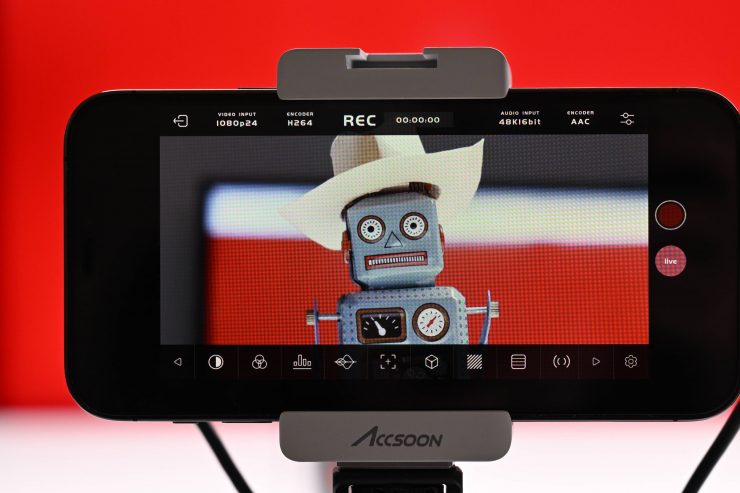
Old version of the app
The small gotcha that used to catch you out is that when you did a pinch to zoom on the screen, it didn’t give you any indication that you are zoomed in. If you forget to zoom back out you may well end up shooting incorrectly framed images. I am glad Accsoon addressed this and the updated version of the app now shows you what percentage you are zoomed in.
Some of the monitoring tools that are available include false color, histogram, peaking, audio meters, waveform, frame guides, etc.
What is nice is that you can adjust the color and intensity of peaking, the position and opacity of the waveform, etc.

You can also adjust the brightness, color range and sharpness of the display.

There is also the ability to use LUTs.
Onboard Recording
The Accsoon SeeMo Pro lets you record video and audio directly to your phone. This is good if you want to upload material quickly to social media platforms, or even have a look back at takes. You could also use it as a second back up recording.

You can change the transmission bitrate and record file limit size to suit your needs.
30Mbps is reasonably decent for an HD recording through an app on a phone. I found that the quality of the recordings was more than good enough for social media use.
It is also good that if you are on location and you need client approval for a certain shot, etc. you can record a clip and then send it to them via iMessage or similar.
Streaming

The Accsoon SeeMo Pro has the ability to live stream. This is pretty straightforward and easy to do and you can stream to a wide array of different platforms. For anyone working in news or events, this is a handy feature to have, especially in emergency situations.
Prolycht ImageTrack RT
Prolycht recently announced ImageTrack RT which is a simple way to track the changing colors of backgrounds and plates. ImageTrack RT is the result of a technical partnership with Accsoon. All you need are lights, an Accsoon SeeMo and an iPad running ImageTrack RT.

The system uses the Accsoon SeeMo Pro SDI or SeeMo HDMI to feed the video image from your camera or playback device into the Prolycht Chroma Link app on iPad or iPhone.

The app then ‘sees’ the image and using ImageTrack RT you can assign points on the screen to be tracked and assigned to different Prolycht Orion or Dedolight neo color LED lights.
Prolycht is touting the system as being ideal for lower-cost virtual production where it would have previously required a complex computing setup to accomplish a similar result.

Once the Chroma Link app has the ability to ‘see’ the image a color can be matched either using the Color Picker tool as a one-time setting, or set to Real-time tracking where the assigned point of the image is used to mirror fast-changing dynamic lighting.
On the simplest level, the Prolycht/Accsoon system can be used to choose a static color to match the image the camera ‘sees’ when sampled. This is higher accuracy than relying on the iPhone or iPad’s internal cameras with their alternative angle on the scene and alternate color processing. A typical use case might be to adjust the color temperature output of Orion lights to accurately match the changing color of sunlight during a shoot. The ImageTrack RT system can also be used to track rapidly changing colors. This is especially useful for virtual production setups where it has previously been complicated to make lights track quick changes in colors on a virtual background or plate. A typical example might be to quickly mimic street lights and neon shop signs passing as a car drives at night.
How does it work?

A small, medium or large sized area on the screen can be selected as the sample area. This is then positioned over the desired portion of the image and a reading is taken. The sampled color is then sent to the Orion light by the app and can also stored as a preset to be recalled later. Multiple sample areas can be selected for tracking and assigned to different lightsFor Full-time tracking the user can then select up to eight points to track on the image and assign a different Orion LED light, or group of lights, to match each one. The intensity of each light, or group of lights, can be set separately.
Does it work well?
I tried this out in conjunction with a Prolycht Orion 300 FS and it works really well. It is super easy to use. Once you have the SeeMo Pro hooked up and running and a Prolycht fixture turned on, you simply launch the ChromaLink app and then go to the ImageTrack RT (Beta) tab.
Above you can see how it works. While it isn’t going to be useful for every scenario I can see it being very handy, especially when you are on location in tricky lighting conditions where you want your light to mimic the light that is already there. It would work well under sodium lamps, street lights, etc.
This is a very clever and inexpensive solution that SeeMo and Accsoon have come up with and they should be applauded for doing this.
Prolycht Fixtures

The Prolycht Hyperlight RGBACL LED engine found in its Orion spotlights intelligently mixes light output from Red, Green, Blue, Amber, Cyan and Lime emitters to create extremely accurate colors over a wide spectrum. It achieves this with a higher level of saturation and intensity than competing RGBW systems that use white emitters. This has significant advantages when used for virtual production where high-intensity color light may be required at some distance from the subject or area being lit. The Prolycht Orion 675FS RGBACL LED light. This Hyperlight color engine is used by the Prolycht Orion 675 FS and 300 FS LED spotlights, as well as the new dedolight neo color fixture. All three fixtures can be controlled by the Chroma Link app and will work with Imagetrack RT.
Boot-up Time
I was curious to see how long it took if everything was powered on and connected up for an image to appear on the iPhone’s screen. I found that it took about 5 seconds longer for an image to appear on the iPhone as opposed to when it appeared on a SmallHD monitor that was also connected up via SDI.
Image Delay

I wanted to see how much image delay the Accsoon SeeMo Pro SDI had when feeding it an SDI signal and monitoring on an iPhone. I did this by comparing it directly to an input going out of another SDI to s SmallHD monitor.
Over a series of tests taken at random intervals, I found that the average latency was only around 10ms. This was good to see because the last thing you want when you are monitoring is to have high latency.
Real World Use

The Apple iPhones have really good, color-accurate displays that put a lot of affordable on-camera monitors to shame, so using one as an onboard monitor certainly makes a lot of sense.
Some of the newer iPhones have very bright screens that you can easily see in sunny conditions. Almost everybody already owns a phone, so being able to use it as a monitor also makes sense. If you have an older iPhone you can turn it into a monitor instead of throwing it out, so that you aren’t tying up your primary phone.
The SeeMo Pro is a jack-of-all-trades solution that you can use to monitor, stream, and record.
Despite the fact that the SeeMo Pro works as advertised I personally just find that by the time you add all of the separate components it just takes up too much real estate to be a viable solution, at least for me. Again, this is just my opinion and others may find it works well for them. However, I would be interested to see what our readers think.

If Accsoon had come up with a solution where you could mount the iPhone directly to SeeMo Pro then I think that would make a lot more sense. Yes, it would make it quite thick and bulky, but I would personally prefer that over having to mount multiple components. I am sure this could be done by coming up with some type of bracket that keeps the phone off the surface of the SeeMo Pro so it doesn’t get too hot.
I don’t want to sound negative, because I like the concept of the product nad its functionality and features. It will be interesting to see who the target market for this product is going to be. On mid to larger-sized digital cinema cameras most users are just going to opt for a dedicated monitor. For users of smaller-sized digital cinema cameras, they will probably find that this solution takes up too much real estate. With the original SeeMo, because it is an all-in-one solution where you just insert your iPhone, it makes a lot more sense for people using mirrorless hybrids or small-sized digital cinema cameras with HDMI outputs.
I think the SeeMo Pro makes a lot more sense as a director’s monitor rather than an onboard camera monitoring solution. Although in saying that, you could just use an AccsoonCineView and send a signal directly to an iPad and monitor that way.
The integration with Prolycht so that you track the changing colors of backgrounds and plates is brilliant, and it’s worth buying the SeeMo Pro just for that very reason if you own a Prolycht fixture.
Price & Availability

The SeeMo Pro SDI will retail for $349 USD and will be available via official Accsoon resellers in Summer 2023.
